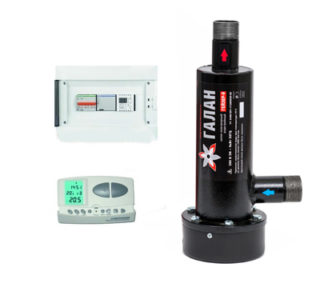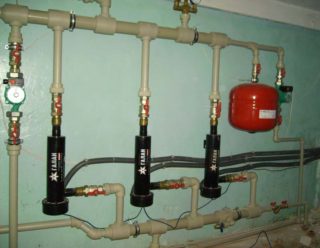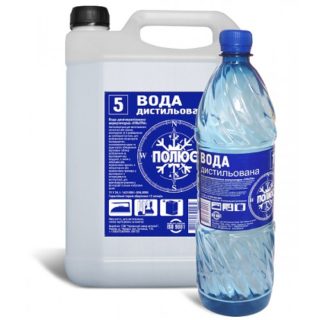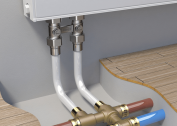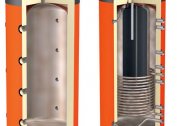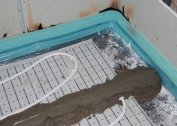The electrode heating boiler operates on the principle of ionization of water under the influence of electricity, when heat is generated, but there is no heating element. The efficiency increases, the period of reaching the set temperature decreases, energy is saved. Autonomous heating works in conjunction with a system of pipes, radiators, operates using pumps, valves. Proper selection and installation of equipment guarantees good heating at low cost.
The principle of operation and features of the electrode boiler
Resistance arises in the coolant when an electric current passes through it, due to the random movement of electrons from the cathode to the anode, energy is released and the liquid is heated. The heating efficiency depends on the type of filler in the system and its properties. The coolant acts as a working element of the electric line, so there is no risk of the boiler switching to dry running. If liquid flows out of the heating system, the circuit opens and the unit stops working.
The installation is characterized by direct action, while additional components are not used. If scale appears on the cathode and anode elements, the power of the ion heating boiler decreases, but the components that pass the current are not destroyed.
Types of electrode boilers
When choosing equipment, the cost and the possibility of installing automatic systems on boilers are taken into account. The area of the house and the correspondence of the strength of the equipment for heating the premises are taken into account.
Devices are classified by:
- power;
- method of connection and power (three-phase or single-phase);
- number of connected loops;
- heat carrier distribution method.
Manufacturers determine the warranty for 3 years, but in fact the equipment lasts up to 10 years. Water is poured into the system; the purchase of expensive antifreeze and special fluids is not required. The case is made of high quality metal.
By the number of circuits
The simplest one is a single loop system. Water from the boiler is supplied to the heating main, moves to radiators, where it gives off energy. The liquid passes through the registers and returns to the place of heating. The closed combination forms the heating circuit.
A single-circuit boiler supplies coolant for heating a house, and a double-circuit unit additionally supplies liquid for a hot water supply system. The electric electrode boiler is powered by a three-phase or single-phase electric power line.
The circuits are connected to the distribution node (collector). The center of the electrode heating system is installed for the correct distribution of heat along the branches of the main.
By the number of phases
Three-phase units operate from a 380 V power supply and are available with a capacity of over 9 kW. The electrodes are made up of plates, rings or cylinders and effectively interact with a heat carrier of low thermal conductivity. The amount of power is inversely proportional to the resistivity of the liquid.
Three-phase devices consume the optimal amount of energy when heating water from + 75 ° C. At a low temperature, thermal conductivity decreases and electricity consumption decreases, the opposite situation occurs when high heating rates are set.
Single-phase electrode electric boilers for heating are less powerful (2 - 6 kW) and are intended for small houses (40 - 120 m2). The type of supply (single-phase or three-phase) is determined in the distribution panel. If there are 3 wires to the house, the first option is carried out, the presence of 4 - 5 wires indicates the second type of consumption.
By power
Power is constantly changing and depends on the temperature of the water. Connecting and starting the boiler in winter may result in a lack of power for heating. If cold water increases the thermal conductivity to normal, after heating the line, the index increases, network congestion and an accident occur.
Electrode electrode boiler for heating is available with power from 2 to 36 kW. In simple models, there is no electronic circuit for stepless or step adjustment. Because of this, there are sharp surges in voltage in the supply network when starting and turning off the unit. This is more noticeable when turning on boilers of significant power.
According to the principle of distribution of coolant
Energy-saving units are installed in the trunk of open and closed type, the latter type is used more often. In an open system, shut-off and control equipment is placed behind the expansion tank. The section of the circuit between the boiler and the compensation tank must not contain locking devices.
A closed system includes an expansion tank and a pump. The heating circuit is equipped with an air and safety valve, a pressure gauge, the safety group is located at the upper point of the highway. In the heating system, boilers are placed strictly vertically and are additionally attached to the wall.
Advantages and disadvantages
The technology of electrode heating allows you to instantly transfer heat compared to heating elements.
Benefits:
- the efficiency is close to 100%, the boiler is small in size and high power;
- no need to organize the exhaust gas;
- there is no risk of an accident due to insufficient or lack of water in the system;
- voltage drops in the supply network do not harm the elements of the boiler.
Electrode heating places high demands on the coolant and works only from the network with the required performance. Be sure to ground the chassis for safety reasons.
Basic coolant requirements
Electric current passes through the heat carrier in the boiler, which increases the risk of electric shock. There are large current leaks, so the residual current device is not used with the unit. Over time, the phenomenon of electrolysis occurs in the coolant and the chemical composition changes. The process causes the release of gases and air accumulates in the system. The selection of the coolant for electrical conductivity is required.
As the heat carrier, you can use rain, filtered or distilled water. The values of the operating current are measured by current clamps. An aqueous solution of soda or salt is added at low conductivity, the procedure is repeated until the required indices are reached.
The efficiency of the electrode boiler
Sometimes old batteries are connected to the unit, which reduces efficiency. Bimetal and steel radiators are suitable for transferring heat from electrode assemblies. System performance is reduced when using cast iron or aluminum batteries.
The wrong diameter of the connecting elements and pipes becomes the cause of energy overruns. The pump maintains a certain pressure, the wrong choice of pump for power will lead to a decrease in productivity. Boilers relate to electrical equipment and require appropriate technical characteristics of the supply wiring.
Installation Nuances
It is better to mount the boiler along with a new circuit made for it. A unit installed in an old heating system consumes more electricity.
During installation, the following subtleties are taken into account:
- with the use of antifreeze, attention is paid to detachable parts and connections, since the fluidity of the coolant is higher than that of water;
- conclusions from the boiler at a distance of 1.2 m are made from a metal pipe without internal galvanizing, and then metal-plastic runs are installed;
- grounding is made with a copper wire with a cross section of 4 - 6 mm with a resistance index of not more than 4 Ohms.
In open systems, heaters are supplied with an internal polymer coating. In closed highways, such an inner layer is not needed, since corrosion occurs only with access of air.
